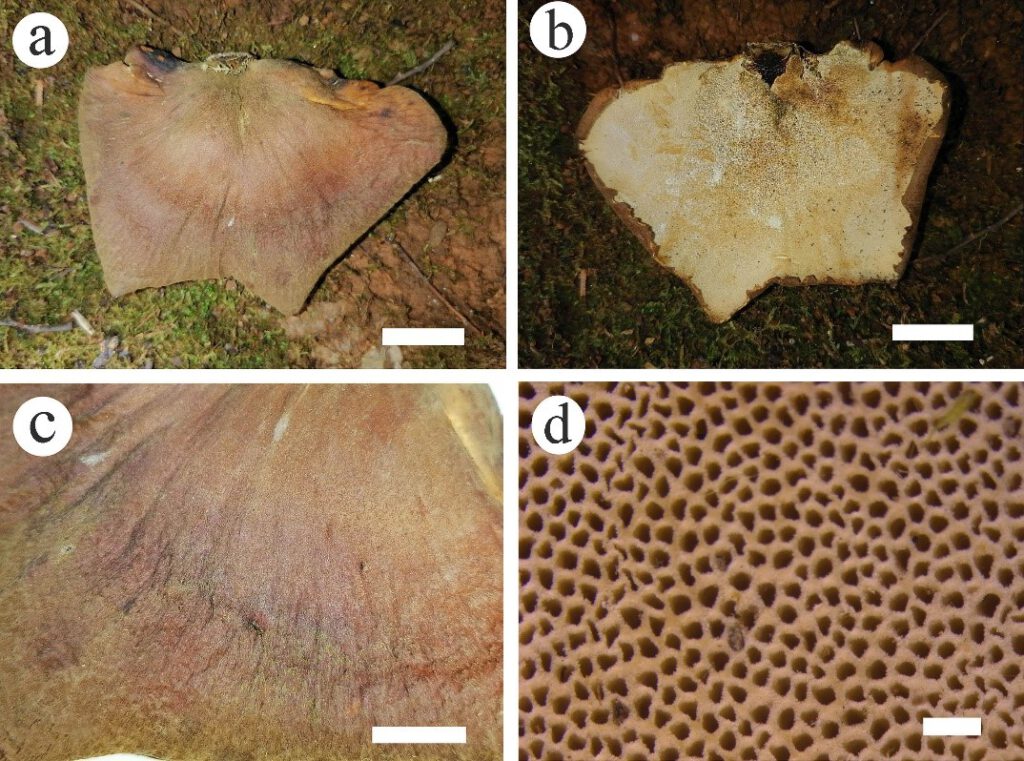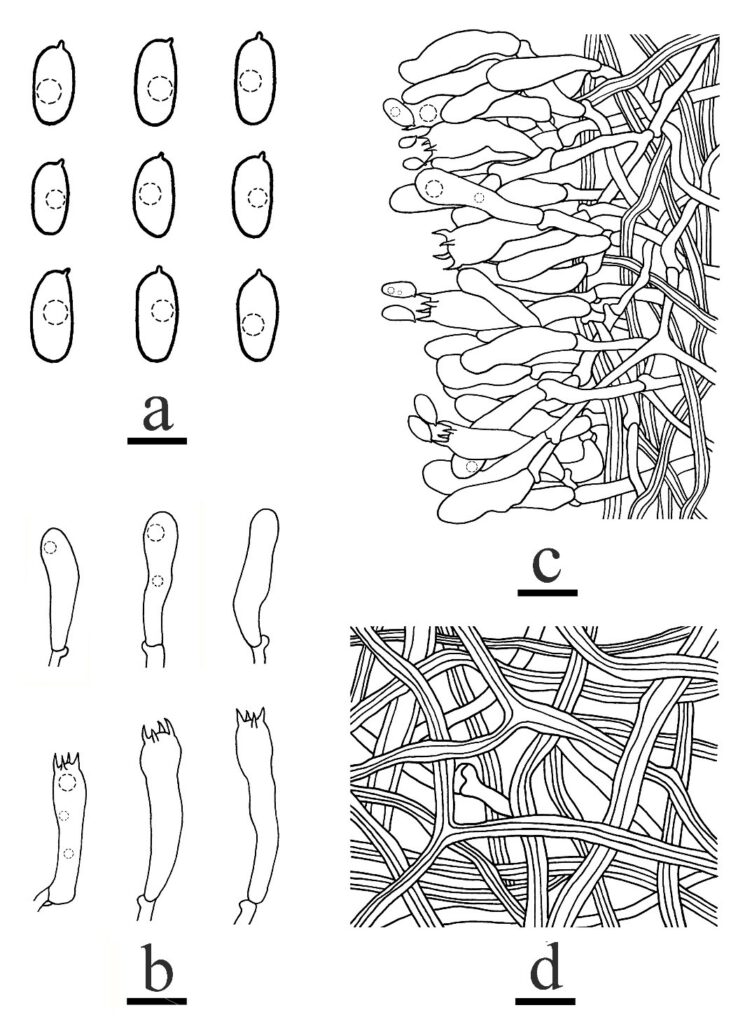Picipes yuxiensis C.L. Zhao, sp. nov.
MycoBank number: MB 559354; Index Fungorum number: IF 559354; Facesoffungi number: FoF 10615; Fig. 31, 32
Etymology: Refers to the provenance (Yuxi) of the type specimen.
Holotype: CLZhao 6332 (SWFC).
Basidiomata annual, laterally stipitate, gregarious, coriaceous when fresh and tough when dry. Pilei fan-shaped to semicircular, up to 8 cm wide, up to 6.5 cm wide and 2.5 mm thick. Pileal surface glabrous, black towards the base and becoming pale brown to reddish-brown towards the edge when fresh, frequently becoming reddish-brown to chestnut across the whole pileus, sometimes brown-beige towards the edge when dry; margin straight when fresh and involute upon drying. Pore surface white when fresh, white to buff when dry; pores round, 3–5 mm; dissepiments thin, entire. Context cream and woody hard upon drying, up to 2 mm thick. Tubes white when fresh and cream to buff upon drying, less than 0.5 mm thick. Stipe very short or forming a flattened base, bearing a black cuticle, up to 2 mm long and 1.2 cm in diameter. Hyphal system dimitic; generative hyphae bearing clamp connections, colorless, thin-walled; skeletal hyphae colorless, thick-walled, branched, IKI–, CB+; tissue unchanged in KOH. Context generative hyphae infrequent, colorless, thin-walled, rarely branched, 2.5–3.5 μm in diameter; skeletal hyphae dominant, colorless, thick-walled with a wide to narrow lumen, moderately branched, interwoven, 3–5 μm in diameter. Generative hyphae frequent, usually present near hymenium, colorless, thin-walled, 1.5–3.5 μm in diameter; skeletal hyphae dominant, colorless, thick-walled with a wide to narrow lumen, unbranching, interwoven, 2–4 μm in diameter. Cystidia and cystidioles absent; basidia clavate, with a basal clamp and four sterigmata, 25–31 × 5.5–7.5 μm; basidioles in shape similar to basidia, smaller than basidia. Basidiospores ellipsoid, colorless, thin-walled, smooth, with an oil drop inside, IKI–, CB–, (5.8–)6–8.5(–8.7) × (2.7–)2.9–3.7(–4) µm, L = 7.28 µm, W = 3.31 µm, Q = 2.01–2.21 (n = 150/5).
Habitat: on fallen branch of angiosperm.
Distribution: China.
Material examined: China, Yunnan Province, Yuxi, Xinping County, Mopanshan National Forestry Park, on fallen branch of angiosperm, 17 January 2017, CLZhao 971, CLZhao 980 (SWFC, HKAS); on dead tree of angiosperm, 18 January 2018, CLZhao 6329 (SWFC, HKAS), on the trunk of angiosperm, 18 January 2018, CLZhao 6375 (SWFC, HKAS); on dead tree of angiosperm, 18 January 2018, (CLZhao 6332 (SWFC), holotype).
GenBank numbers: ITS: MZ325828, LSU: MZ325830 (CLZhao 971); ITS: MZ325827, LSU: MZ325829 (CLZhao 980); ITS: MZ325826 (CLZhao 6329); ITS: MZ325825 (CLZhao 6332); ITS: MZ325824 (CLZhao 6735).
Notes: Picipes yuxiensis formed a monophyletic lineage as a sister clade to P. jiajinensis (Fig. 33). Picipes yuxiensis differs by 73 base pairs in the ITS region and 32 base pairs in the LSU gene. Picipes jiajinensis differs from P. yuxiensis by its reddish-brown to black pileal surface, lateral stipe with a black cuticle, oblong to cylindrical, smaller basidiospores (5.4–6.1 × 2.5–2.9 µm) (Cui et al. 2019). Picipes jiajinensis also differs as it was collected on coniferous wood in high altitude area.

Fig. 31 Basidiomata of Picipes yuxiensis (CLZhao 6332 (SWFC), holotype). a, c Pileal surface. b, d Pore surface. Scale bars: a, b = 2 cm, c = 1 cm, d = 5 mm.

Fig. 32 Microscopic structures of Picipes yuxiensis (CLZhao 6332 (SWFC), holotype). a Basidiospores. b Basidia and basidioles. c Hymenium. d Hyphae from context. Scale bars: a = 5 µm, b–d = 10 µm.

Fig. 33 Maximum parsimony strict consensus tree illustrating the phylogeny of Picipes species based on ITS and LSU sequences. Related sequences were retrieved from GenBank and Zhao and Wu (2017). The dataset comprised 2046 characters, of which 1609 characters were constant, 60 were variable and 377 were parsimony-informative. Maximum parsimony analysis yielded 100 equally parsimonious trees (TL = 1185, CI = 0.536, HI = 0.464, RI = 0.685, RC = 0.367). The GTR+I+G model was used in the BYPP analysis. Bayesian posterior probabilities analysis and ML analysis resulted in a similar topology to MP analysis with an average standard deviation of split frequencies = 0.007231 (BI), ESS = 330. The tree is rooted with Polyporus tuberaster. Branches are labeled with maximum likelihood bootstrap values ≥ 70%, parsimony bootstrap values greater than 50% and BYPP greater than 0.95 BYPP. The newly generated sequence is in blue.
